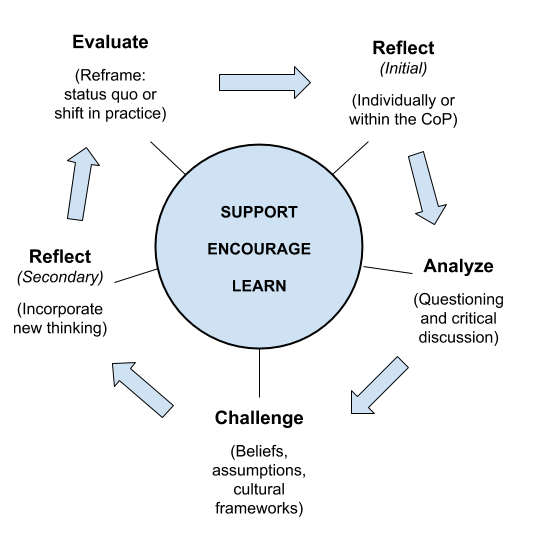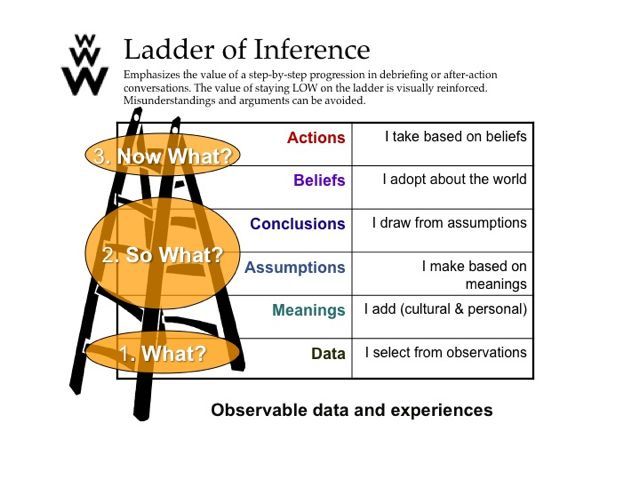Introduction
In this module, we explore the importance of reflection in EL, and discuss how partners can structure and engage students in meaningful reflective activities.
This module has been designed for all audiences.
Menu
- What is the importance of reflection for learning in experiential education?
- How can a community partner engage students in meaningful reflection?
- What reflective activities and prompts are appropriate to specific experiential education opportunities?
- Planning and development worksheet
- References for this module
What reflective activities and prompts are appropriate to specific experiential education opportunities?
Examples and Artifacts
External Links
link Benefits for Employers/Partners
link Benefits for Faculty
diagram Ladder of Inference
Another interesting way to view reflection is to compare it to the Ladder of Inference, which describes the thought process we follow to get from a fact to an action.
(image source: http://www.liberatingstructures.com/9-what-so-what-now-what-w/ CC-BY-NC)
document Making Experience Count: The Role of Reflection in Individual Learning
In this paper, the authors review the effect of two different sources of learning - the accumulation of additional experience (experiential learning) and articulating experience accumulated in the past (reflection).
document Reflection: A Tool for Success
This paper examines how reflective practice is increasingly being used as a tool to improve both employee and organisational success.
document Experiential Learning and the Reflection Process
This document discusses models for reflection and a broader summary of stumbling blocks in Humphrey’s Model of Reflection.
document Weighing up the balance - some ways of overcoming the barriers to effective reflective writing
This document discusses some of the challenges that individuals feel when they engage in reflective writing practices.
video The Power of Reflection at Work
Prof. Giada Stefano who discusses how reflecting on what you have done enables you to do it better next time.
What is the importance of reflection for learning in experiential education?
Examples and Artifacts
External Links
table Reflective models
There are a number of models that can be used to guide the reflective process. There is no “right” model; students can choose the one that is most comfortable or most useful for helping them to learn from their experience. This table presents a summary of common models for reflection.
diagram The Reflective Hub
The Reflective Hub is a visual representation of how the Community of Practice (CoP) model and reflective processes combine to reframe thinking, actions and beliefs. Though the hub is designed in a cyclical manner, it is not intended to be a prescribed flow, as one can move in and around each phase through the centre of the hub. The core values of the CoP are included in the centre of the model. These are to learn, to support, and to encourage, and are considered to be at the heart of the CoP process. The outer cycle is viewed as the learning framework.

(adapted from: Looking at Reflection within a Community of Practice of RTLBs; Soljan, Ivanka; Stanghan, Yvonne; Henry, Anna Kairaranga)
document Best Practices in Experiential Learning
For an overview of best practices in experiential learning, including teaching reflection, have a look at this document prepared by Michelle Schwartz, Research Associate, for the Vice Provost, Academic, Ryerson University.
link Critical Reflection
The University of Waterloo offers these guidelines for integrating reflections into your course.
document A Practical Guide for Work Integrated Learning
Page 65-85 of this document provides a number of useful resources for facilitating reflection such as a reflection map, reflection exercises and assessment tools.
document Reflection: A Tool for Success
This article focuses on how reflective practice is increasingly being used as a tool to improve both employee and organisational success.
document Guidance on Student Self-Reflection
This document includes suggestions for how to encourage reflective practice and self-evaluation.
What reflective activities and prompts are appropriate to specific experiential education opportunities?
Examples and Artifacts
External Links
summary document Factors to consider
Making a choice on whether you want to add reflection into an experiential learning opportunity depends on a number of factors. This document sumarizes some main considerations.
document A Practitioners Guide to Reflection in Service Learning
This document is a good resource for anyone seeking to use critical reflection in service learning, including teachers, students, program leaders, and community agency representatives.
document The Reflective Toolbox
This document includes a number of questions for prompting reflection, with a specific focus on the DEAL model.
document Facilitating Reflection: A Manual for Leaders and Educators
This document covers a variety of topics such as understanding reflection, facilitating reflection (ex: communications, trouble-shooting), and reflection activities.
document Reflection Activities
This document includes an index of reflection techniques.
document Reflection Activities: Service-Learning’s Not-So-Secret Weapon
This document outlines a variety of traditional as well as creative reflection techniques that you can incorporate as classroom activity or as an outside assignment.
Planning and development worksheet
This worksheet can be completed online or exported so you can continue work on it. Note that If you advance another module or visit another site, your work will not be saved. Be sure to export your document before continuing.
Recommended next module (all audiences):
Supporting the Integration and Mobilization of Knowledge Skills and Competencies in EL
